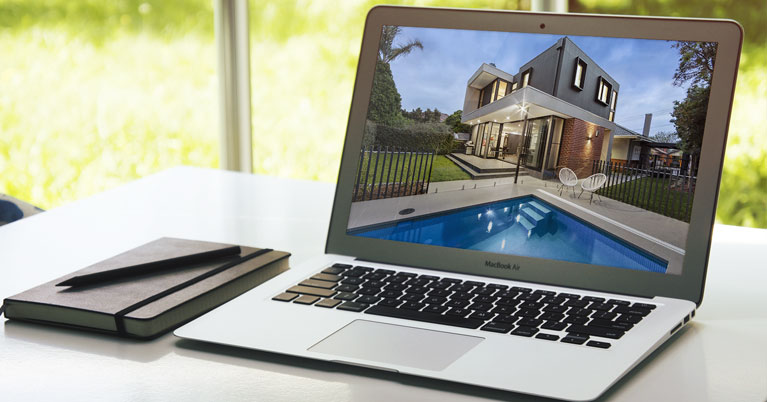Building on my previous post, Storybrand – using the hero’s journey to create a more compelling website, the following are examples of how one industry — real estate — can utilize the various components of Storybrand to develop more compelling copywriting for their agency’s website.
The Wireframe
The following is an example of a basic real estate website wireframe that contains all of the major components of the Storybrand framework. At minimal, all of the following components should be present within your real estate agency’s website Home page. Each element can also be included in other pages presented on your website related to specific content for real estate buyers and sellers as well as the page dedicated to promoting your team of agents.
Components of a Storybrand website:
- The Header
- The Problem/Stakes
- The Solution
- The Guide
- The Plan
- The Call To Action
Here is how the following looks when laid out in the format of a web page wireframe:

The Header
The Home page header is the most important part of your entire website. The purpose of the header is to provide your potential real estate clients with a bird’s eye view of exactly what it is your business does. When you are finished creating your header, review it with several people to see if it passes the “grunt test”. This means that someone who is completely unfamiliar with your agency can clearly identify what it does within the first 10 seconds of viewing your website. They should be able to answer the following 3 questions: What do you offer? How will it make their life better? What do they need to do to buy it?
The Headline: What does your ideal client want? This should be a general statement that is in direct relation to the services you provide Ex. “Find your dream home without hassle.” “Buy or sell your home with confidence.”
Try to be clear and concise, not clever. Trying to be too clever about the wording here only confuses your clients.
The Subheadline: What do you do, in relation to what your target customer wants? Ex. “We guide your real estate success with our exceptional expertise and extraordinary service.”
Background photo: A simple way to add some visual impact to your Home page header is to add a large background photo that shows examples of your target clients enjoying the results of the services you deliver. This of course doesn’t have to be a background photo but could also be accomplished using an illustration or collage of photos and graphics, as long as it has the intended result of demonstrating the positive results achieved by doing business with you.
Transactional call to action button: What do your clients need to do in order to do business with you? Ex. “Schedule a Call” “Talk With a Real Estate Expert”.
Transitional call to action button (optional): If your clients aren’t yet ready to do business with you, where can they go to help them make their decision? Ex. “Watch our video”, “Download top 10 tips for buyers and sellers”
These CTA buttons should be placed strategically throughout the website, providing your customers plenty of prompts to purchase or engage in your marketing funnel. Buttons should also stand out visually (make them large with contrasting colors and/or drop shadows) so they are not overlooked on the page.


Elements of success statements:
Elements of success statements are three headlines/clarifying statements that are typically displayed directly beneath the header. These are used to identify and describe 3 main ways in which your clients will succeed if they utilize your services.


The Problem/Stakes
This is a one paragraph section that may also incorporate bullet points that describe the potential cost of not doing business with you. For example: “Are you touring too many homes that don’t meet your needs? Frustrated because your listing isn’t getting attention from eager buyers? Stressed by the lack of support and guidance?”, followed by a description of the hassle most people face when trying to buy or sell a home without the support of an experienced realtor.
For this section, answer one or more of the following questions:
- What problems are your customers experiencing that’s driving them to look for a new/different real estate agent?
- How does that problem make them feel? Make sure you include both external problems and the emotions people experience because of them.
- What is the cost of not utilizing your services?
Also, be sure to use empathy in this statement, showing that you identify with your customer’s problems. For example, you can begin the statement with “We understand how it feels to struggle with…”


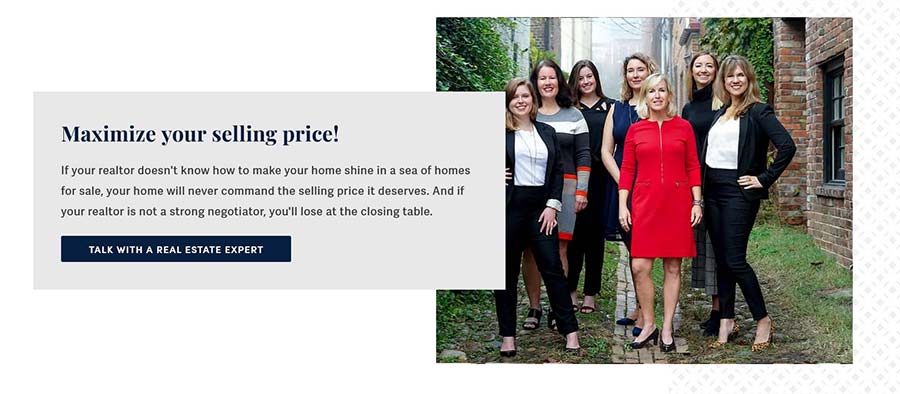
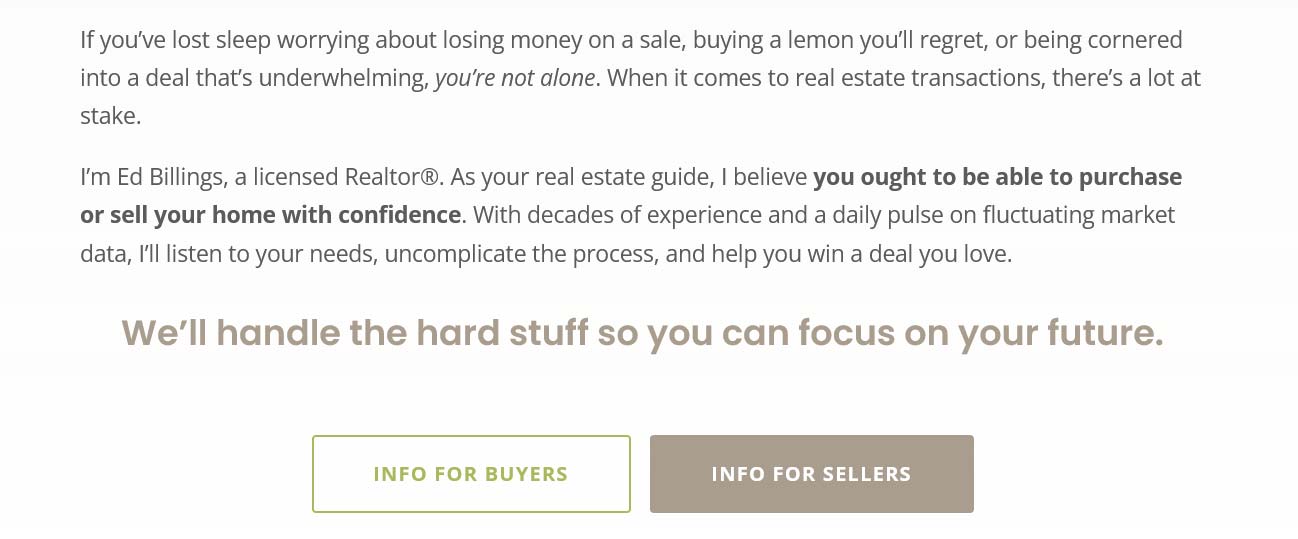
The Solution
After identifying and empathizing with your target client’s main problems, you can then position yourself as a guide by presenting them with the solutions you provide and a plan for what they can do next. For example, “Exceptional service. Extraordinary experience. We believe that buying a home should be fun and selling a home should be simple. That’s why we listen to your needs and lean into two decades of contract and sales experience to lead buyers and sellers like you from frustrated to fulfilled. Talk with one of our expert real estate agents today.”
When presenting your solutions, be sure to also state the ways in which your agency differentiates or stands out from other agencies so that you aren’t just presenting the same solutions as every other agency. Also, state the benefits you provide your customers in a way that gets across the emotional impact that they have on your clients. For example, you don’t just “sell houses”, you “provide clients with peace of mind, knowing that they got the best return on their real estate investment.”


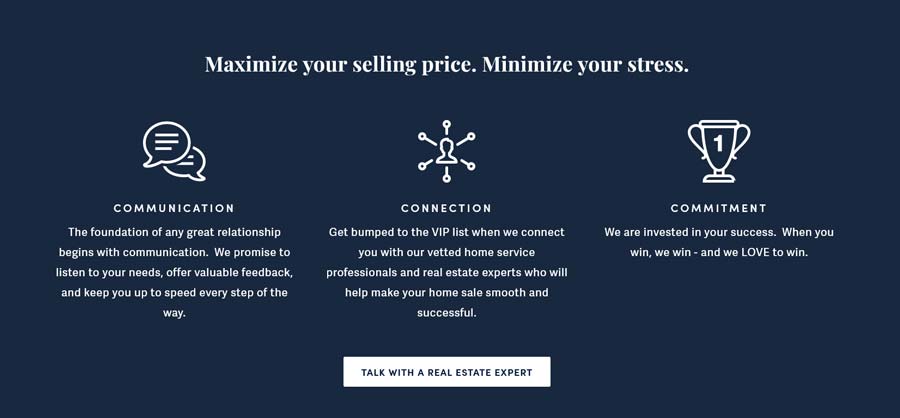
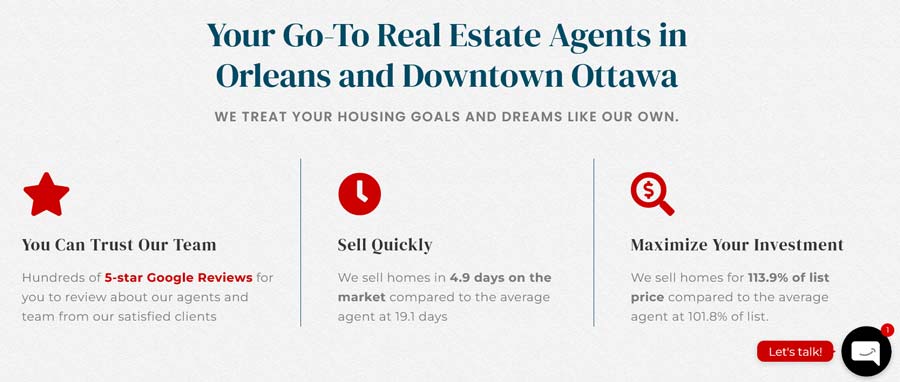
The Guide
Establishing yourself as a trusted guide isn’t necessarily accomplished in just one section of the page, but is done rather by displaying a variety content throughout the entire website that that helps to convey the two most important aspects of any guide: authority and empathy. Authority is the knowledge, skill and experience that a guide possesses, while empathy is the ability to understand the problems that their customers are facing.
Communicating authority on your website can be achieved by displaying customer testimonials, experience and credentials, or simple statistics such as number of clients worked with, money earned or saved for clients, or number of years in business.
To best communicate empathy in the writing on your website, you can begin statements that address customer pain points with phrases such as “We understand how it feels to struggle with…” You can also use some testimonials from clients that state how much you cared for them.


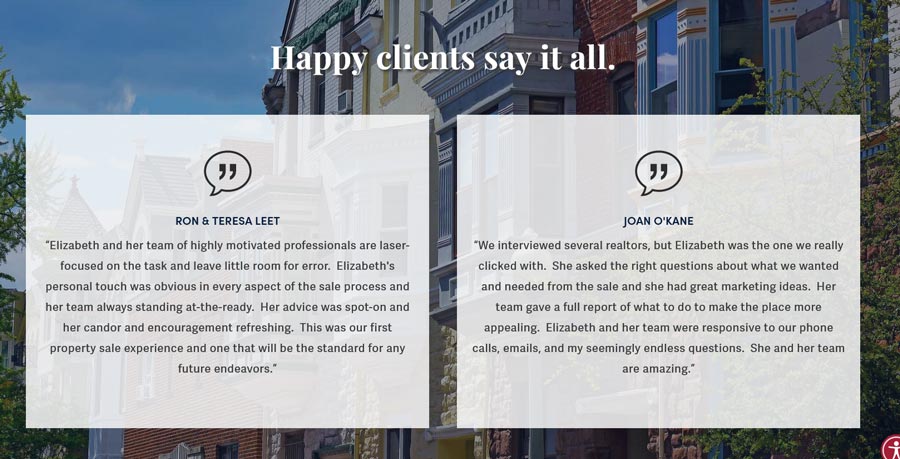
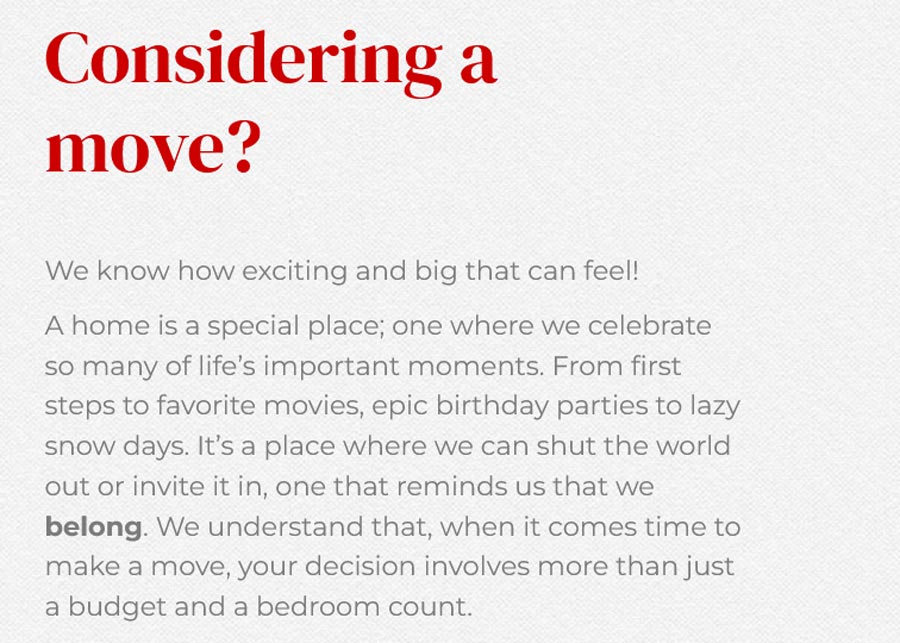

The Plan
What steps occur throughout the process of buying and selling a home? Break down the process into 3-5 bitesize steps that make your customers say, “I can do that!” You can also add a 1-sentence description under each step, including benefits received for each. In this section, it is important to keep the plan simple and easy to understand. Even if it is more complicated or longer than you are presenting, try to distill it into the 3 most essential steps to make it easier for your customers to comprehend and therefore want to take the next steps towards doing business with you.

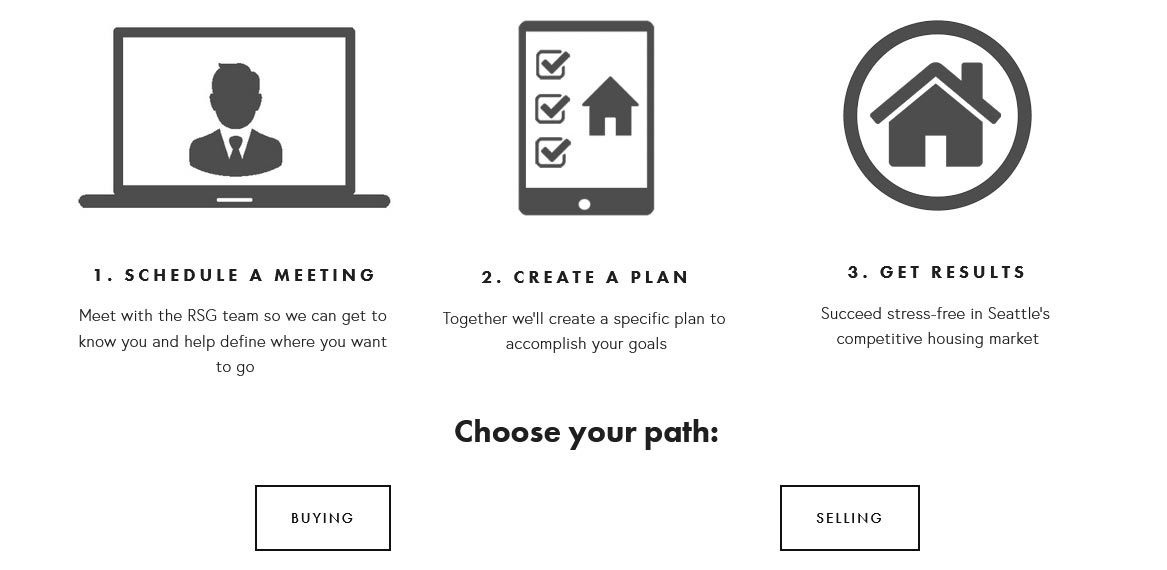
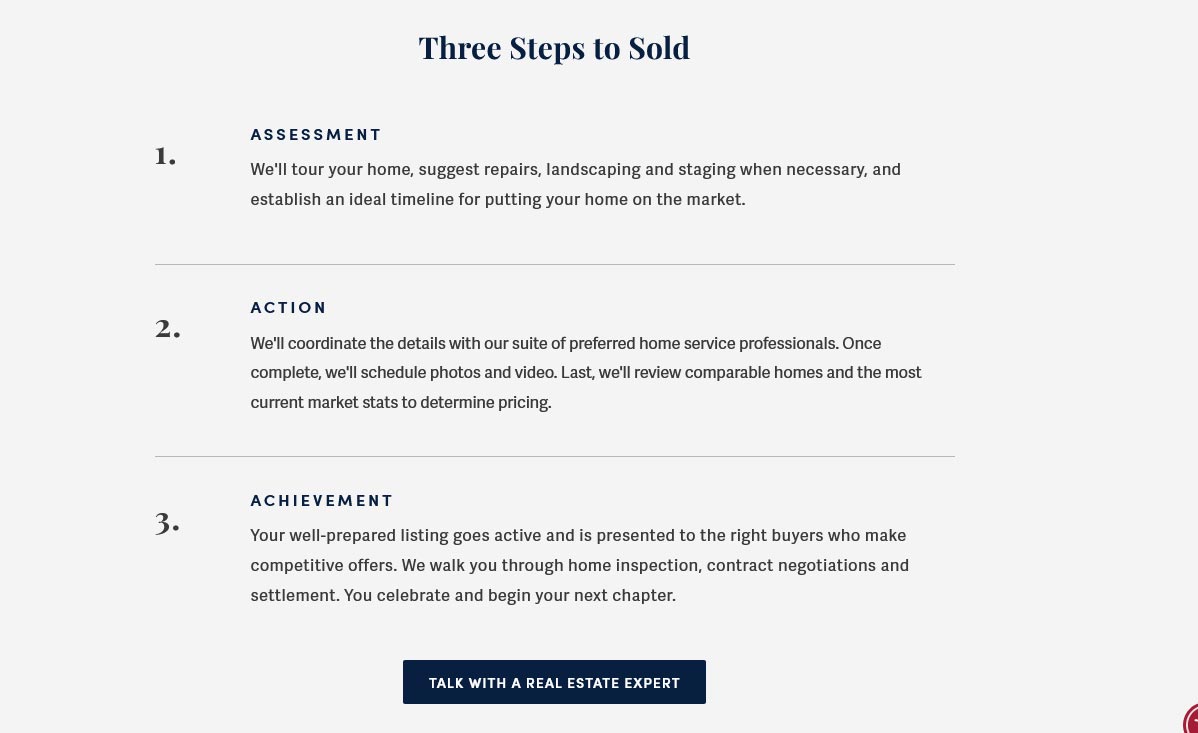
Call To Action
Aside from including buttons throughout the page that direct your potential clients to a contact or other page where you want them to take an action, your “Plan” section should also conclude with the main call to action that you want all your clients to eventually take — calling you to discuss buying or selling a property.
You may consider also including a Call To Action directly afterwards to sign up for your email list in case they are not yet ready to call, but want to learn more or receive updates about new properties in their area. In order to encourage potential clients to subscribe to your list, it’s recommended that you send something of value in exchange such as an educational ebook or video that provides them with information related to buying or selling their home.



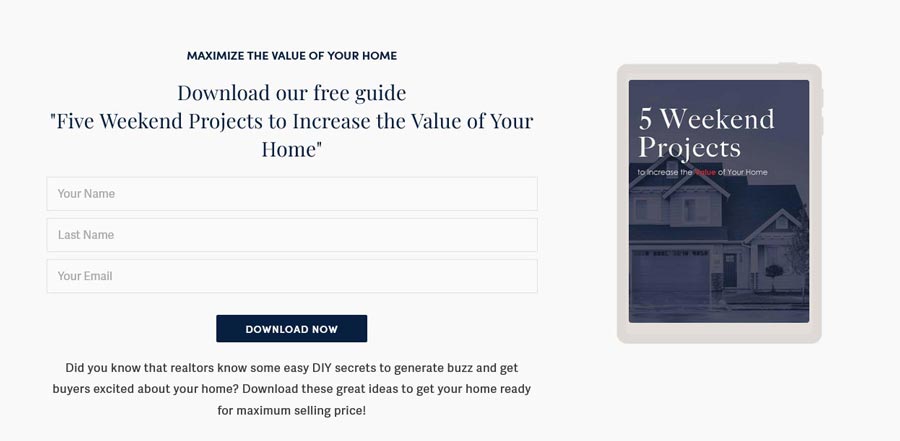
Conclusion
The purpose of this overview is mainly to provide a reference point for working within the Storybrand formula to help clarify the messaging for your business and more effectively present it through your website to make a greater impact for your target audience. For additional resource, check out Building a StoryBrand: Clarify Your Message So Customers Will Listen and Marketing Made Simple: A Step-by-Step StoryBrand Guide for Any Business.
Credits: The following websites were referenced in this article: https://edbillings.com, https://lizluke.com, https://riseseattlegroup.com, https://redpost.ca


